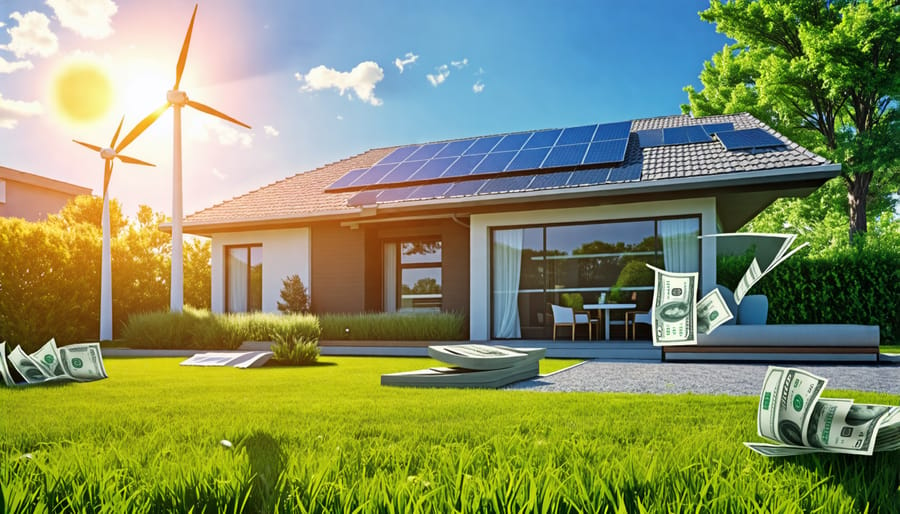Imagine a future where clean, renewable energy powers your home, reducing both your carbon footprint and reliance on the grid. A residential wind turbine can be a key part of making that vision a reality. But with any significant home improvement, cost is a crucial factor.
So just how much does a wind turbine cost for a house? The answer depends on several variables, but expect to invest anywhere from $10,000 to $70,000 for a grid-connected 5-15 kW turbine fully installed. While that may give some homeowners sticker shock, it’s important to consider the long-term financial benefits.
A well-sited small wind turbine can lower your electricity bills by 50-90%, and many systems have a lifespan of over 20 years. Combined with incentives like the 26% federal tax credit, accelerated depreciation, and net metering, a wind system could pay for itself within 6-15 years. Imagine two decades or more of clean, low-cost energy after that!
In this comprehensive guide, we’ll break down all the factors that impact wind turbine costs, estimate the savings you can expect, and explore financing options to make your renewable energy goals attainable. Get ready to harness the wind and reap the financial rewards.

Factors Affecting Wind Turbine Costs
The cost of a residential wind turbine is influenced by several key factors. Turbine size plays a significant role, with larger turbines generally having higher upfront costs but also greater energy output potential. The location of the turbine site can impact costs due to varying wind speeds, terrain, and local regulations. Sites with higher average wind speeds and fewer obstacles tend to be more cost-effective. Soil conditions, access to the site, and proximity to existing electrical infrastructure also affect installation expenses.
Other variables that can influence the total cost include the height and type of tower (freestanding or guyed), foundation requirements, and the complexity of the electrical system. Opting for a grid-connected system may incur additional costs for inverters and meters, while off-grid systems require batteries for energy storage. Maintenance costs should also be considered, as regular inspections, repairs, and part replacements are necessary to ensure the turbine’s long-term performance.
It’s important to note that while upfront costs can be substantial, the long-term savings on electricity bills and potential income from net metering can offset these expenses over time. Factors such as local electricity rates, available incentives, and the turbine’s energy production will determine the payback period and overall financial viability of the investment. Consulting with a professional installer can help assess site-specific factors and provide a more accurate cost estimate for a residential wind turbine project.
Estimating Energy Savings and ROI
Average Energy Savings
One of the primary reasons homeowners invest in residential wind turbines is the potential for significant energy savings. The exact amount saved will depend on factors like wind speed, turbine size, and household energy consumption. However, a well-placed 5 kW turbine in an area with average wind speeds around 12 mph could generate approximately 8,000 kWh per year.
With the average U.S. household using about 10,649 kWh annually, this means a wind turbine could theoretically cover up to 75% of a home’s energy needs. Assuming an electricity rate of $0.13 per kWh, that translates to energy savings of around $1,040 per year.
Over the 20+ year lifespan of a wind turbine, these savings can really add up. Even if the turbine only covers 50% of energy needs, it could still save over $20,000 in the long run. Plus, any excess energy generated can often be sold back to the grid for additional income or credits.
While upfront costs may seem high, the long-term savings potential makes wind turbines an attractive option for eco-conscious homeowners looking to reduce their carbon footprint and their energy bills. With proper siting and maintenance, a residential wind turbine can be a smart investment in a greener, more financially sustainable future.
Return on Investment Timeline
Determining the return on investment (ROI) for a residential wind turbine depends on factors such as initial costs, energy output, electricity rates, and incentives. While the upfront investment can be significant, a well-sited turbine can provide long-term savings and even generate income.
Payback periods for home wind turbines typically range from 10 to 30 years, depending on the system’s size, wind resource, and local electricity prices. In areas with high electricity rates and favorable wind conditions, the payback period can be on the shorter end of this range.
Over the turbine’s lifetime, which is usually 20-25 years, the financial benefits can be substantial. By generating your own clean electricity, you can reduce or eliminate your utility bills, saving thousands of dollars. If your turbine produces excess energy, you may be able to sell it back to the grid through net metering programs, creating an additional income stream.
Moreover, investing in a wind turbine can protect you from future electricity price increases and contribute to a more sustainable future. As technology improves and more incentives become available, the long-term ROI for residential wind power is expected to become increasingly attractive for environmentally conscious homeowners.
Incentives and Financing Options
While the upfront costs of installing a residential wind turbine may seem daunting, there are several government incentives, tax credits, and financing options available to help offset the upfront costs. The federal government offers a Residential Renewable Energy Tax Credit, which allows you to claim 26% of the total cost of your wind turbine installation on your federal income taxes. This credit is set to decrease to 22% in 2023 and expire in 2024, so acting soon could result in significant savings.
Many states also provide their own incentives, such as grants, rebates, and additional tax credits. These vary by location, so it’s essential to research the specific programs available in your area. Some utility companies even offer net metering programs, which allow you to sell excess electricity generated by your wind turbine back to the grid, potentially offsetting your energy bills.
For those who cannot pay the full cost upfront, several financing options are available. Some manufacturers offer leasing programs, allowing you to install a wind turbine with little to no upfront costs. You’ll pay a monthly fee for the duration of the lease, which may be offset by the energy savings your turbine generates. Green energy loans, offered by some banks and credit unions, provide another avenue for financing your wind turbine installation. These loans often come with competitive interest rates and flexible repayment terms.
By taking advantage of these incentives and financing options, the long-term financial benefits of a residential wind turbine can be realized sooner, making this renewable energy solution more accessible to environmentally conscious homeowners.





